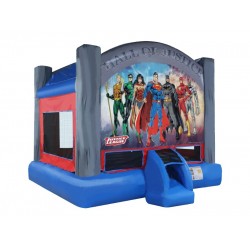What Happens If the Bounce House Deflates During Setup?

Setting up a bounce house should be a straightforward process, but sometimes, the inflatable can begin to deflate during setup. This situation can be caused by a variety of issues, such as power interruptions or air leaks. Knowing what to do if a bounce house deflates during setup will help ensure a safe and smooth process. Below are the possible causes and steps to take if this happens.
1. Power Interruption
The most common cause of deflation during setup is a power interruption:
- Check the Power Source: Ensure that the blower is properly plugged into a working outlet. If using an extension cord, verify that it is securely connected.
- Blower Malfunction: If the blower is plugged in but not working, check the fuse or breaker and inspect the blower for any damage.
- Restart the Blower: If the issue was a temporary power interruption, restarting the blower will usually re-inflate the bounce house.
2. Air Leaks
If the blower is functioning but the bounce house is still deflating, it may have an air leak:
- Check for Tears or Holes: Inspect the seams and material for visible tears or punctures that could be causing air to escape.
- Patch the Leak: If you find a small hole, use a repair patch to cover the leak and prevent further deflation.
- Monitor the Situation: After patching, monitor the bounce house to ensure it remains properly inflated.
3. Improper Closure of Air Vents
Many bounce houses have air release flaps or zippers that need to be securely closed:
- Check Air Vents: Ensure that all air vents, zippers, and flaps are fully closed before inflation. Open vents will allow air to escape and cause deflation.
- Secure All Closures: Double-check all closures to confirm they are secure and that no air is leaking from these points.
4. Environmental Factors
Wind or outdoor weather conditions can also affect the stability of the bounce house:
- Wind Interference: Strong winds can push air out of the bounce house or cause it to shift, leading to partial deflation. Always set up bounce houses in low-wind conditions.
- Anchor the Bounce House: Ensure the bounce house is securely anchored with stakes or sandbags to prevent movement or tipping during setup.
5. Blower Size and Compatibility
If the blower isn't powerful enough to fully inflate the bounce house, deflation can occur:
- Check Blower Size: Make sure the blower being used matches the bounce house's required airflow capacity.
- Upgrade the Blower: If the current blower isn't sufficient, consider upgrading to a more powerful blower that meets the manufacturer's specifications.
Conclusion
If a bounce house deflates during setup, it’s important to identify the cause quickly. Check for power issues, air leaks, improperly closed vents, or environmental factors that may be contributing to the deflation. By troubleshooting and addressing the issue, you can ensure a safe and successful bounce house setup.



